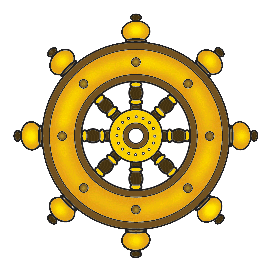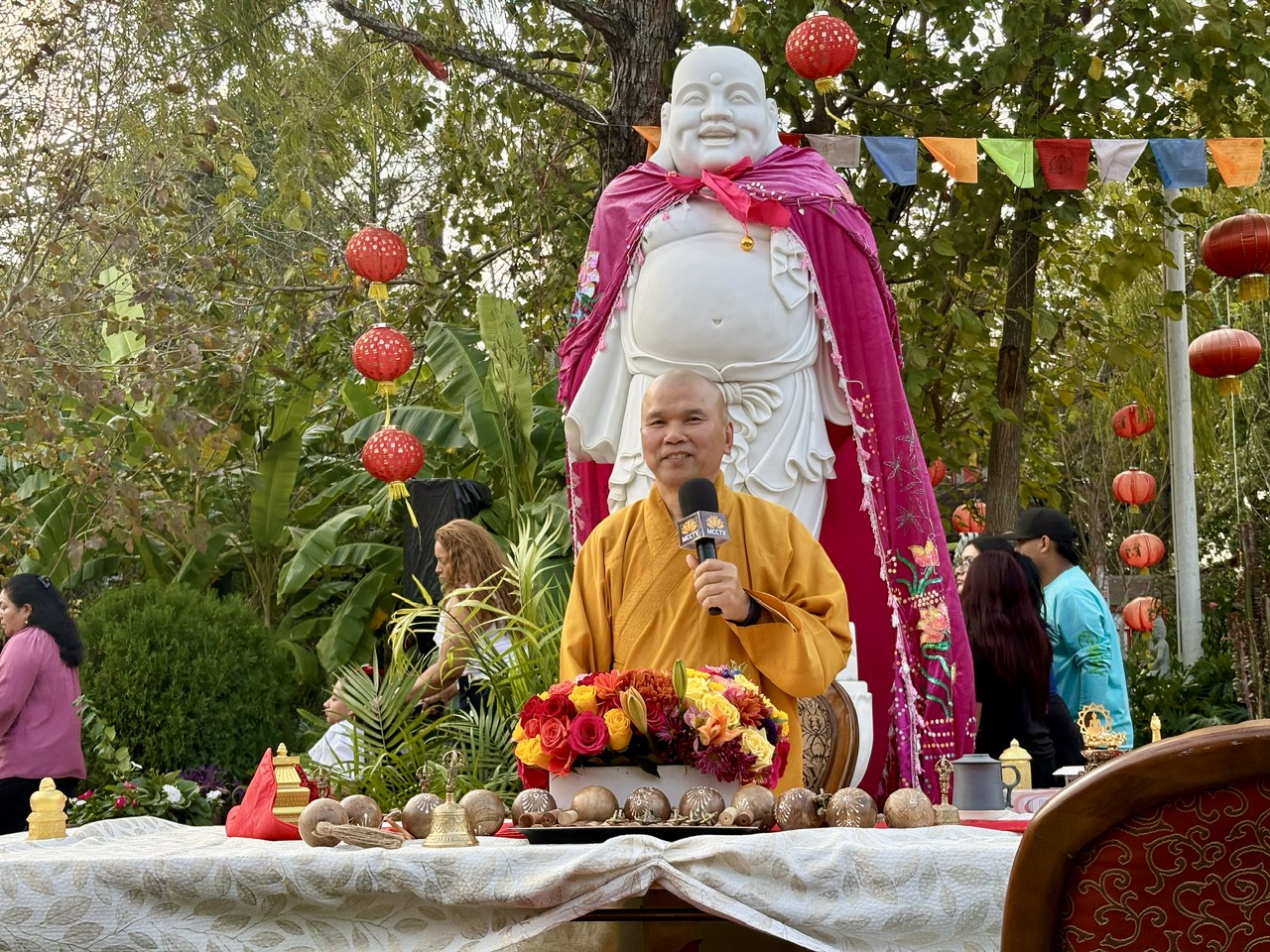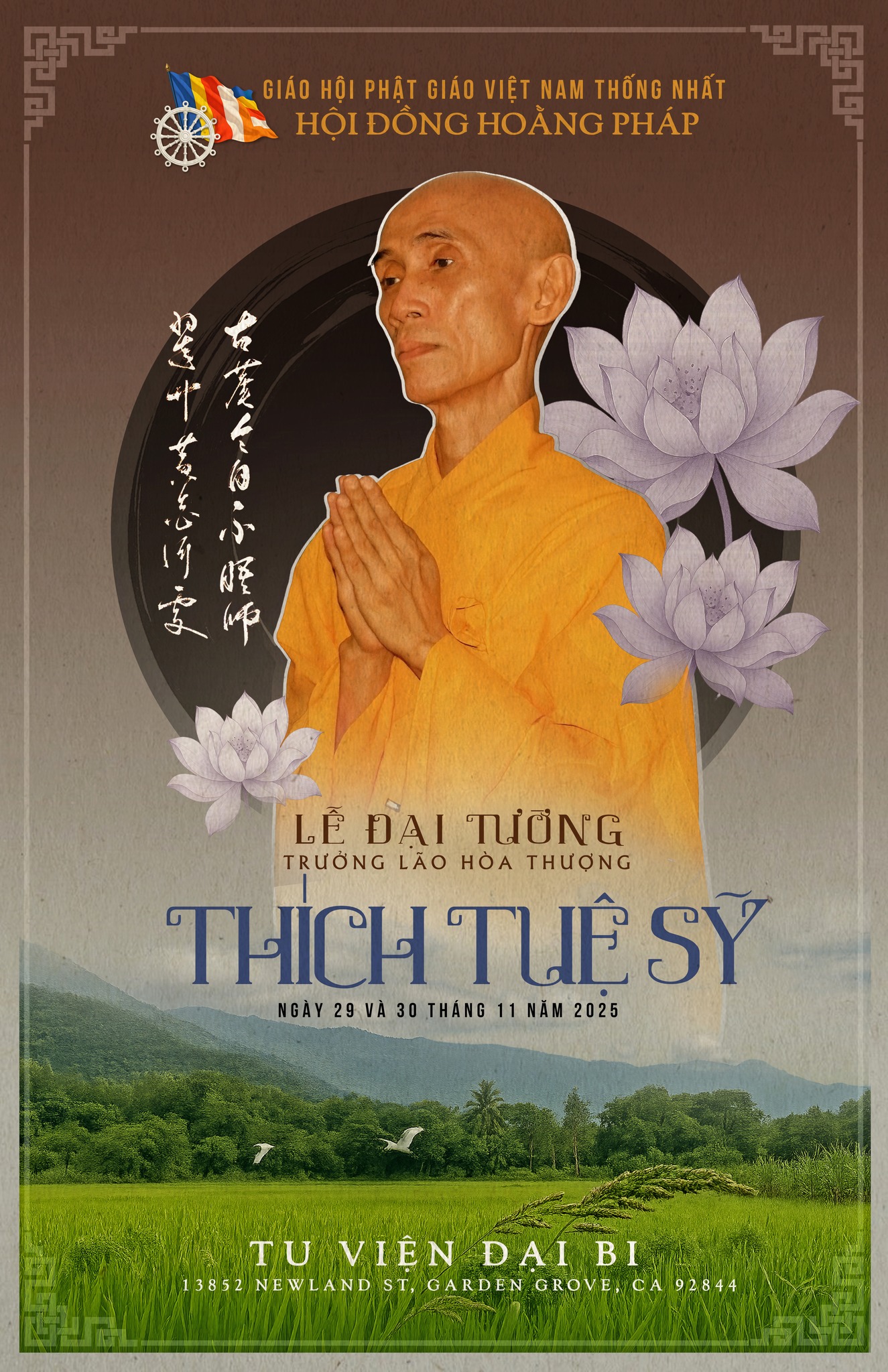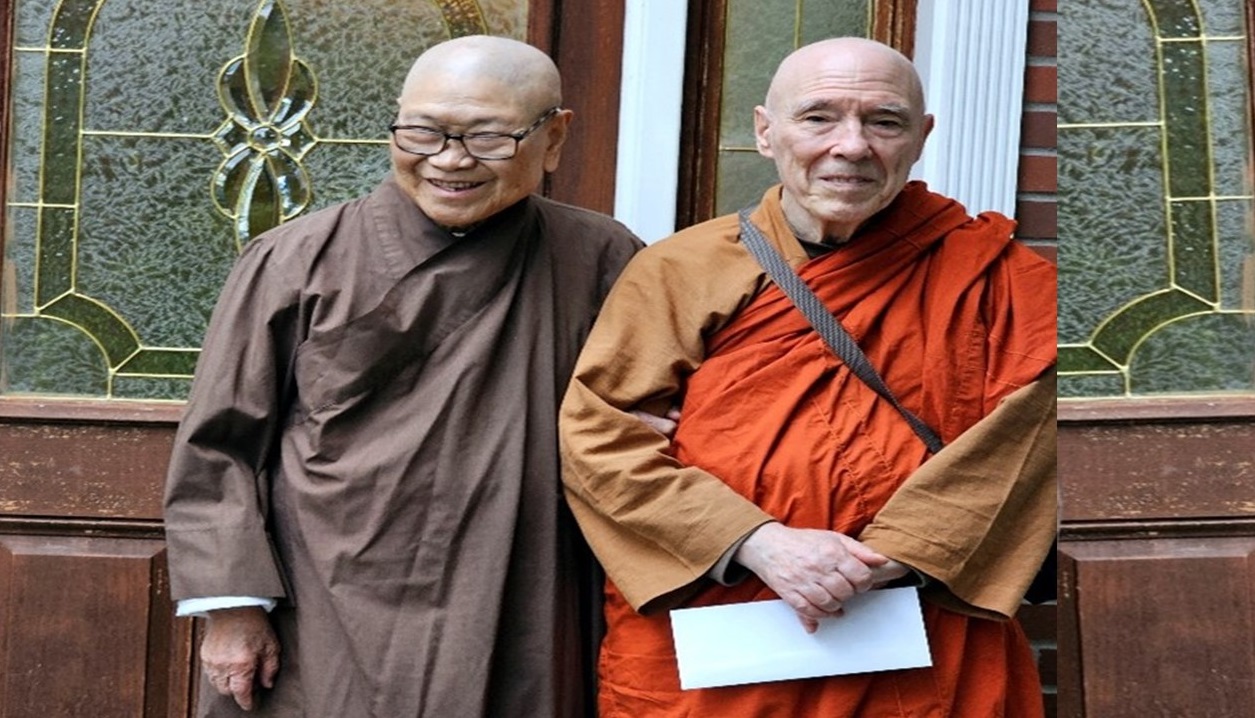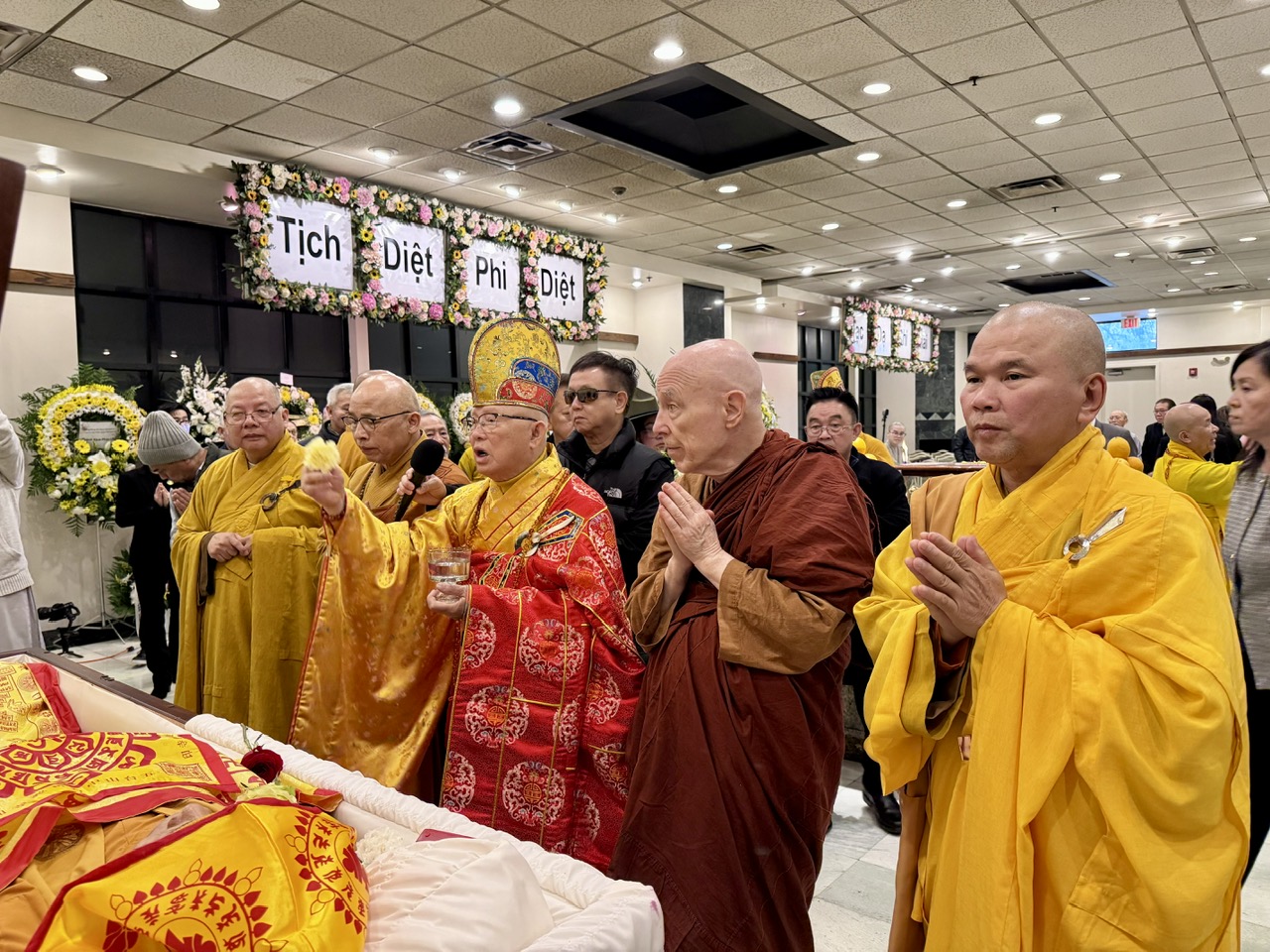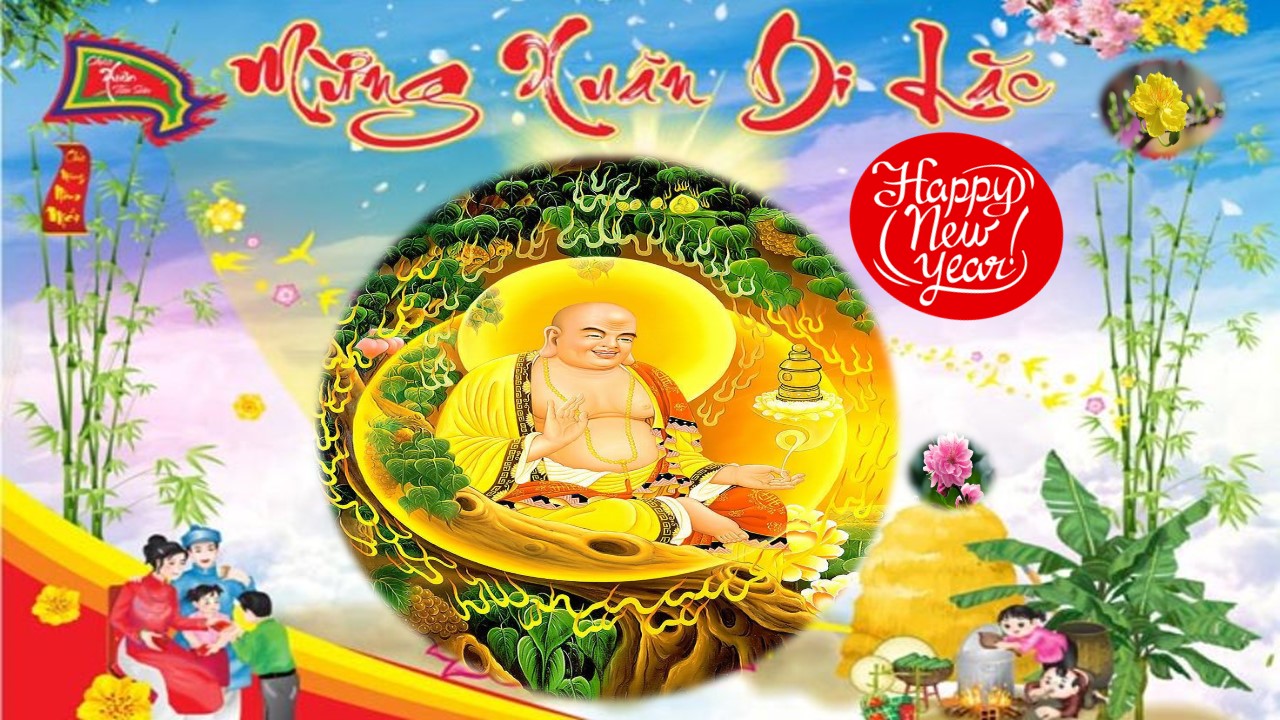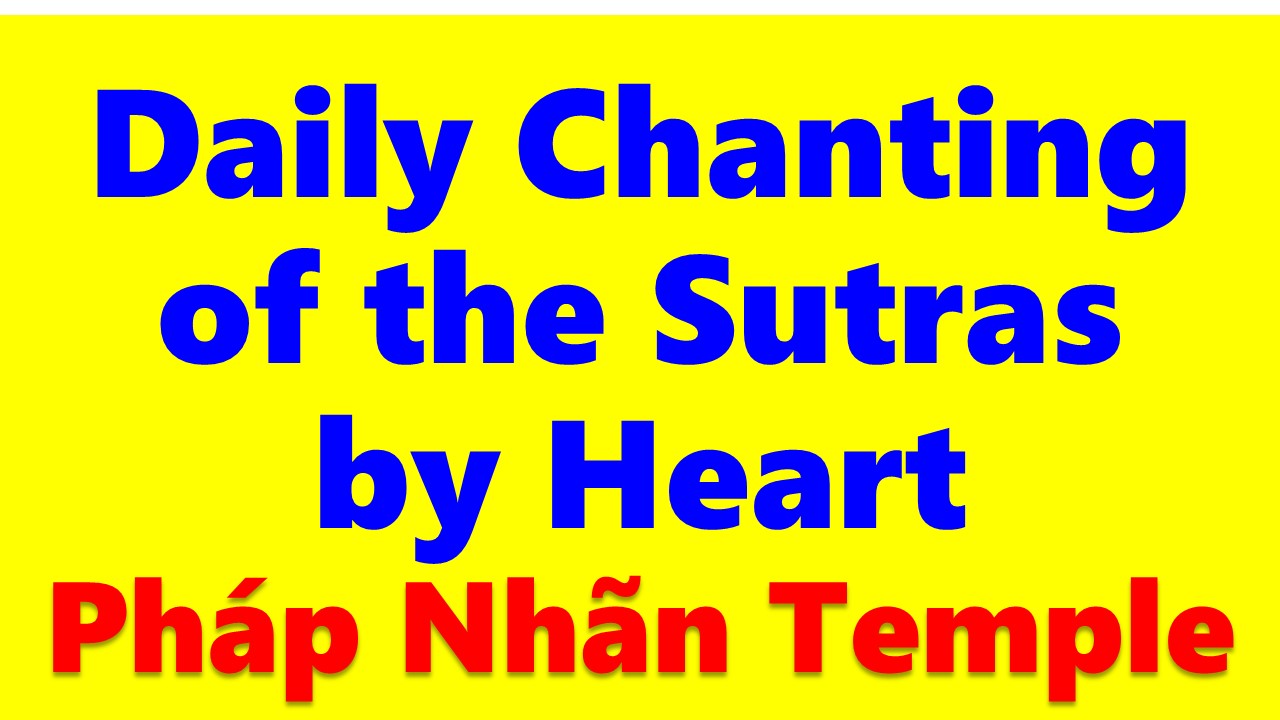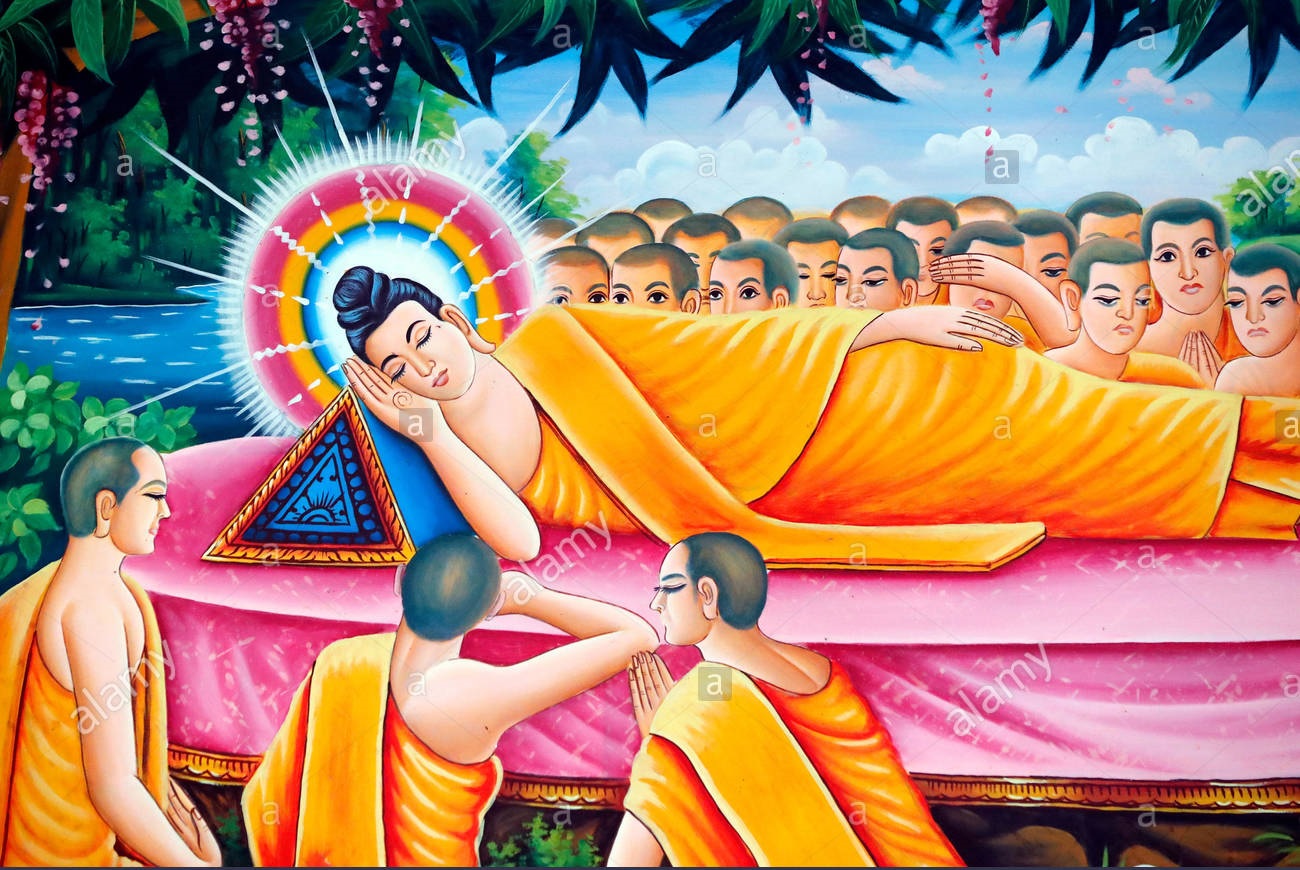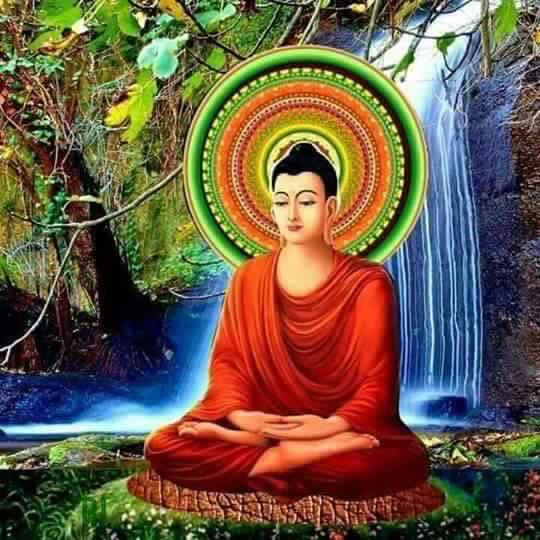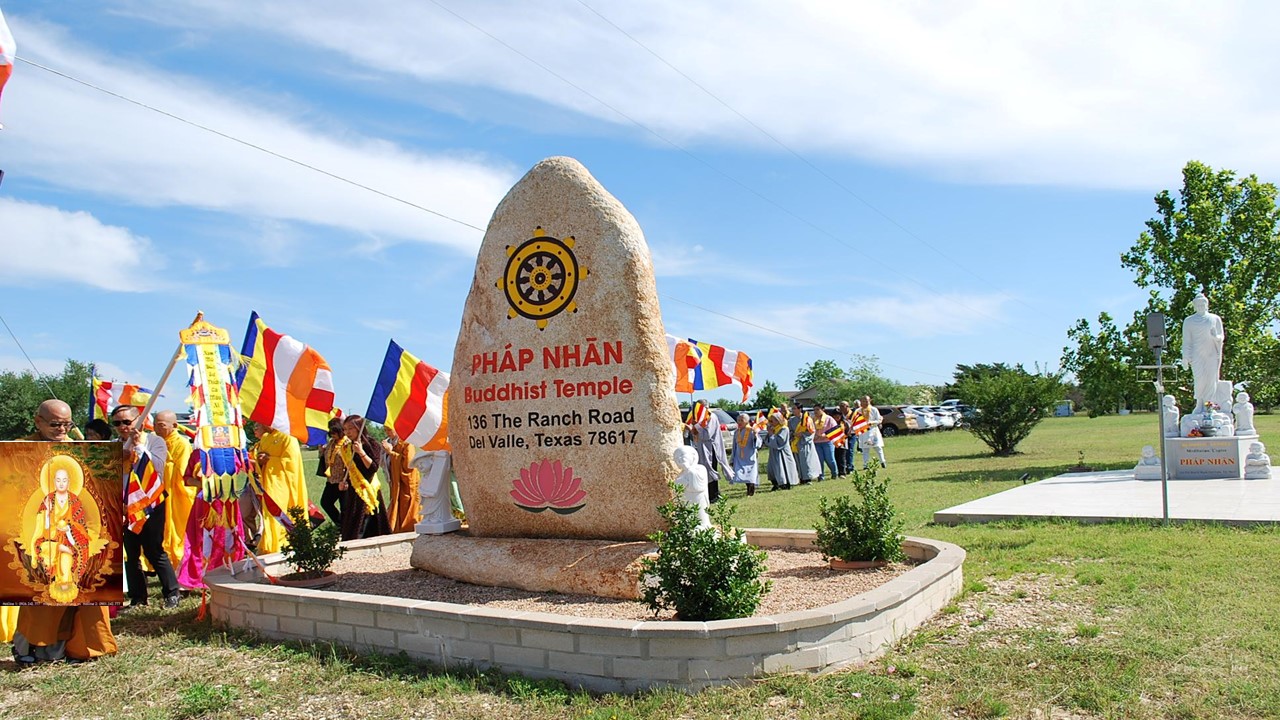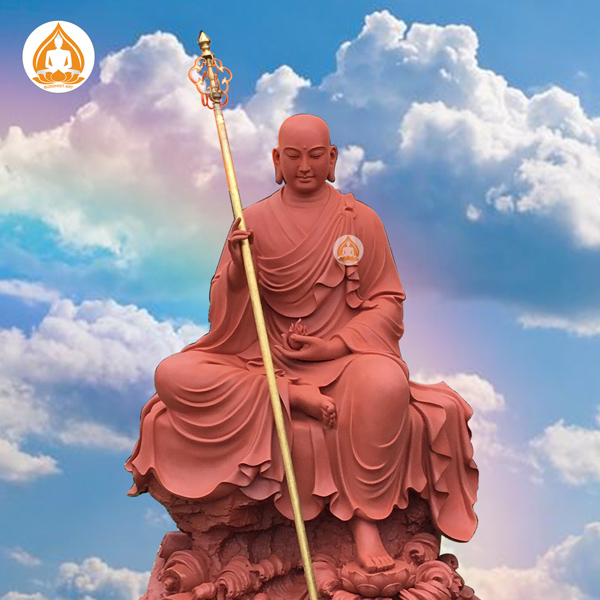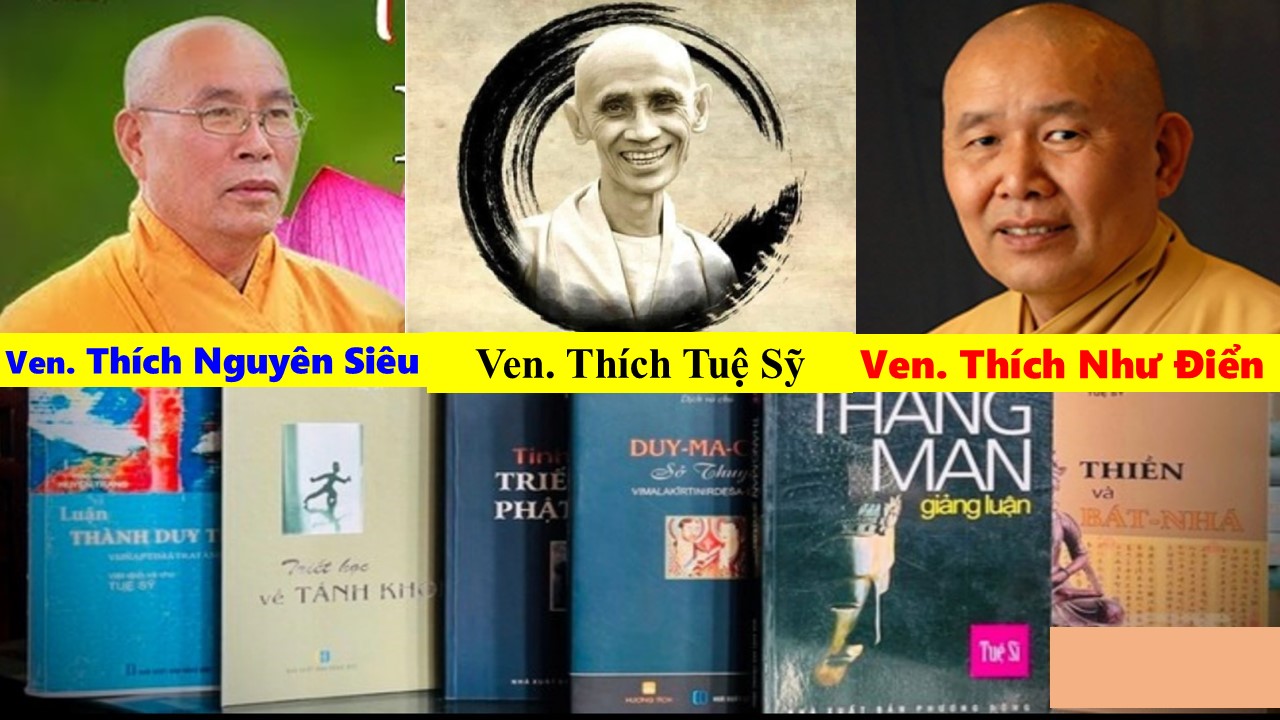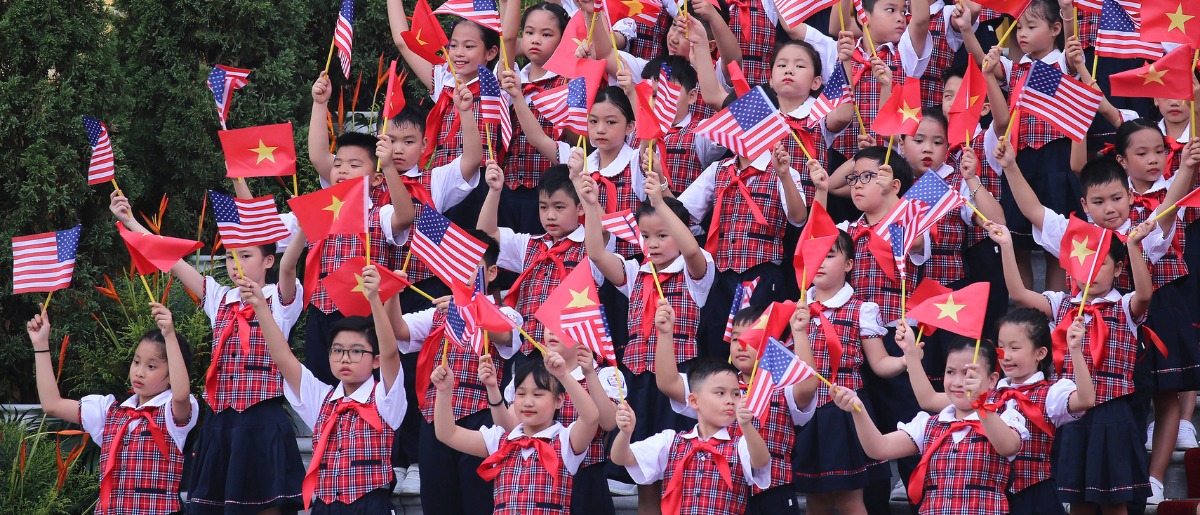
THE BUDDHA VESAK IN CULTURE AND PEACE
13 questions and 13 answers below are very insightful.
Questioned by the Commission of Spreading the Dharma in Europe
Answered By Venerable Thích Trừng Sỹ
Senior Venerable Thích Trừng Sỹ
MC: Sister Thiện Thảo
Technician: Brother Nguyên Mãn
Pay homage to Lumbini Garden, where Sakyamuni Buddha appearing under the Sorrowless Tree.
1) Brief Introduction to Dharma Preacher:
I, Thiện Thảo, would like to respectfully pay homage to Monastic people and your presence
I would like to respectfully pay homage to Senior Venerable Thích Trừng Sỹ, a special guest for today’s Talk show, and I also welcome Buddhist friends.
We wish you all good health, wisdom, and peacefulness🙏
Dear the Venerable, we are extremely grateful to you accepting the invitation of the Organizing Committee and warmly welcome you. For the first time, you come to the Dharma discussion of the European Dharma Spreading Commission.
Next, we would like to have a few words to introduce the Venerable to the audience.
Senior Venerable Dharma name is Thích Trừng Sỹ
Thầy was born in 1968 in Nha Trang City, Khánh Hòa Province, Vietnam.
In 1985, Thầy has left home for monastic life at Linh Nghĩa Temple, and is an official disciple of the Most Late Venerable Master Thích Như Tịnh, the Head Monk, who founded the Linh Nghia Temple in Diên Khánh District, Khánh Hòa Province.
In 1993, Thầy was legally ordained and received higher Ordination as a Bhikkhu on the Great Precepts Transmission Ceremony of Trí Thủ I at Long Sơn Temple in Nha Trang City, Khánh Hòa Province.
In 1994, Thầy graduated with an Intermediate Buddhist Studies diploma in Nha Trang City, Khánh Hòa Province, Course I, the Second Class.
In 2001, Thầy graduated from Vietnam Buddhist University with a Bachelor’s Degree in Buddhist Studies in Sài Gòn City – Course IV, the Third Class.
In 2004, Thầy graduated from Delhi University, India, with the Master of Arts’ Degree in Buddhist Studies, the First Class.
In 2005, Thầy graduated from Delhi University, India, with a Master of Philosophy Degree in Buddhist Studies, the First Class.
In 2009, Thầy graduated from Delhi University, India, in an excellent position with a Doctor of Philosophy Degree in Buddhist Studies.
In 2012 – 2014, Thầy worked as the Dharma Teacher at Linh Sơn Temples in Austin and Leander, Texas.
At the end of 2014, Thầy and Buddhist devotees had enough good conditions to buy the land with a single home and Thầy founded and established Pháp Nhãn Temple in the vicinity of Austin, Texas.
At the beginning of 2015, Thầy has been the legal Abbot until today. There he propagated the Buddha Dharma to Buddhists and non-Buddhists in the United States of America.
In 2018, Thầy passed his citizenship exam and officially became a US citizen.
We would like to respectfully introduce a few brief words to the Venerable. (Bow)
Dear the Venerable, reading through your biography, we deeply respect your Dharma learning and Dharma practice.
In your will and vow of propagating the Dharma, you spent a lot of time making your own great effort, in order to share his experiences and guide us Buddhists to practice the Buddha Dharma and achieve peacefulness and happiness right in the present life.
Today, we vow to listen to your teachings on the topic “THE BUDDHA VESAK IN CULTURE AND PEACE,” in order to follow the perfect example of Sakyamuni Buddha, stably step on the path of cultivation, and vow to benefit ourselves and other people.
Question 1: Dear Thầy, referring to the Buddha’s Birthday is referring to the birth year of Sakyamuni Buddha, and I know that many Buddhists are confused in the calculation of the year of his birth, because the Buddhist calendar does not count from the Buddha’s birthday. Can you remind us how to calculate the year of Buddha’s birthday and the year of Buddha’s passing away?
Answer: Sakyamuni Buddha was the historical Buddha born in 624 B.C.E. (Before Christ Era). We take 624 + 2025 (the current year) = 2649; 2649 is the birth year of the Buddha.
There are two ways to calculate the Buddhist calendar:
- 2649 – 80 (the year the Buddha passed away) = 2,569; 2,569 is the year of the Buddhist calendar since the Buddha entered Nirvana.
- 624 – 80 = 544; 544 + 2025 = 2569; 2569 is the year of the Buddhist calendar being calculated since the Buddha entered Nirvana.
Question 2: Dear Thầy, the Buddha’s Birthday season reminds us of Lumbini garden, where the Buddha was born, the North of India, in a part of today’s Nepal. I have a question, why in the position was he a prince, but he was not born in the palace of his father, but he was born in Lumbini garden from 25 kilometers away.
Please narrate the scene of his birth at that day so that we have a deeper impression on this great event.
Answer: A) In ancient times, we know Nepal is in India. Indian culture in the past as well as today is matrilineal, according to the mother. When a married woman is about to give birth to her first child, she must return to her biological parents to prepare for the first birth. Therefore, Holy Mother Maya also followed this custom. When she knew that the time to give her birth was coming, accompanying her entourage, the Holy Mother returned to her parents’ hometown for her first birth, but on the way to Lumbini garden, the Holy Mother Maya gave birth to a son named Siddhartha, who is fully satisfied with both virtue and wisdom. The main means of transportation at that time was only horse-drawn carriages. There are a few important events associated with the Buddha’s life:
- Being born under the Sorrowless Tree (Ashoka) in Lumbini garden
- Obtaining perfect enlightenment under the Bodhi tree in Bodhgaya
- Passing away under the twin Sala trees in Kushinagar
- Giving the first Dharma Sermon to a five-monk group at the Deer Park (Sanarth)
The above four events of the Buddha’s life are associated with the natural environment.
Thus, from the past to the present day, Buddhism has always promoted the natural environment very valuably and effectively.
- B) The stone pillar at King Ashoka‘s Rummindei was inscribed with the birthplace and year of the Buddha‘s birth in Brahmi. The stone pillar was inscribed: “When the Buddha was born, people in Lumbini at that time only paid 1/8 tax. In December 1896, Dr. Alois Anton Führer, a German, discovered this stone pillar and emphasized that Sakyamuni Buddha, the historical person in the flesh and bone, was real in the human history, was born under the Sorrowless tree in Lumbini garden in 624 B.C.E.
Ekapuggalavagga of Angutara Nikaya or Agama Sutta states as follows: “A unique being, an extraordinary person, appears in this world, out of peace for the many, out of happiness for the many, out of welfare and benefit for gods and human beings, it is the historical person – Sakyamuni Buddha.’’
Characteristics of the Holy Pregnant Period
During the holy pregnant time, holy Mother Mayadevi and King Suddhodana along with the people in the palace all did good things, said good things, and thought of good things, specifically vowed to have vegetarian food to nourish and develop the mind of the holy fetus. The fetus directly influenced 80% the pure and holy consciousness from the mother, and the father only 20% through the ways of walking, standing, lying, sitting, sleeping, talking, acting, consuming, eating, thinking, etc. Therefore, during pregnancy, the mother and father are very careful about taking care of the fetus. We know that the fetus of a normal human born in the world is called the secular fetus; The fetus of a Buddha born in the world is called the holy fetus. Indeed, thanks to taking care of the holy fetus very devotedly and thoughtfully, when the newborn baby Buddha was born, Mother Maya became his biological mother.
Question 3: In the articles describing the event of the Buddha’s birth, there are many symbolic languages, such as the image of a six-tusked white elephant entering the mother’s womb in a dream, the image of the newborn baby Buddha walking 7 steps, on the ground rising seven lotuses to support his feet, and the image of the Buddha raised one right hand index finger pointing up to the sky and one left hand index finger pointing down to the ground. Please explain to us the meaning of these symbols, so that we can see more clearly the dignity of the person of the Buddha that the symbolic language has tried to express.
Answer: We know according to Indian literature, the number 7 is the perfect number with many great philosophical, religious, literary, musical, and spiritual meanings.
a) Seven steps walking on 7 lotus flowers represent 7 days from Monday to Sunday in a week.
b) Seven steps walking on the 7 lotus flowers represent the 7 stages of enlightenment of holy people
- Stream Enterers (Sotāpanna)
- Once Returner (Sakadāgāmī)
- Non Returner (Anāgāmī)
- Arahant
- Solitary Buddha (pacceka-buddha)
- Bodhisattva
- Buddha.
c) Seven steps walking on the 7 lotus flowers represent the 7 Buddhas:
- Vipassi Buddha
- Sikhin Buddha
- Visvabhu Buddha
- Krakucchanda Buddha
- Kanakamuni Buddha
- Kassapa Buddha
- Sakyamuni Buddha.
d) Seven steps walking on the 7 lotuses represent the 7 factors of enlightenment:
- Dharma Investigation (dhamma vicaya)
- Effort (viriya)
- Joy (pīti)
- Tranquility (passadhi)
- Mindfulness (saṭi)
- Concentration (samādhi)
- Equanimity (upekkhā).
e) Seven steps walking on the 7 lotuses represent the 7 types of specific wealth of holy people; the holy people here are understood as us, the practitioners, the disciples of the Buddha.
1. Confidence of wealth (saddhādhana) is the noble treasure that helps us to have the right and profound confidence in the Three Jewels.
2. Virtue of wealth (sīladhana) is the noble treasure that helps us protect the body, speech, and mind of purity and cleanness.
3. The Shame Sense of the Wealth with oneself (hiridhana): Feeling ashamed of oneself is the noble treasure for the unwholesome things that one cause to oneself.
For example, a person drinks alcohol, he can not control himself. When he gets drunk, angry, he scolds and beats other people, etc. After drunkenness is over, he recalls the wrong actions caused by his alcohol drinking. He feels ashamed of himself. It is the shame sense of the wealth with oneself.
4. The Shame Sense of the Wealth with other people (ottappadhana): Feeling ashamed of other people is the noble treasure for the unwholesome things that we cause to other people.
For example, a person takes what is not given. Those who find him say that he is a thief. He feels that their words are very correct and feels ashamed of themselves. It is the shame sense of the wealth with other people.
5. The Hearing of the Wealth (sutadhana): Extensively learning and widely understanding the Dharma are the noble treasures for those who practice Buddhist studies diligently and mindfully.
6. The Giving of the Wealth (cāgadhana): In all kinds of almsgivings, Dharma giving is the noblest treasure that help people clearly understand, recognize, and transform their greed, avarice, and stinginess.
7. The Wisdom of the Wealth (paññādhana): Wisdom of Dharma hearing, wisdom of Dharma practice, and wisdom of Dharma thinking are the noble treasures that help people understand deeply about cause and effect, impermanence, suffering, interdependent arising, interdependent origination, and the Noble Eightfold Path.
f) Seven steps walking on 7 lotuses represent musical notes with the 7 syllables:
- Do – Mi – Sol (D major)
- Rê – Fa# – La (R major)
- Mi – Sol# – Si (M major)
- Fa – La – Do (Fa major)
- Sol – Si – Re (Sol major)
- La – Do# – Mi (La major)
- Si – Re# – Fa# (Si major)
g) Seven steps walking on the 7 lotus flowers represent time and space existing in the universe:
The time has 3: The Past, the present, and the future.
The space has 4: The East, the West, the South, and the North.
Throughout the time and space for more than 26 centuries, for the powerful vow of saving sentient beings, the Buddha appeared in the world. The characteristics of Buddhism has never been a religious war while world religions, including religions born in Vietnam had ever had religious wars.
The Buddha is the King of peace, his disciples are the messengers of peace. The Buddha and his disciples all together taught peace to the world in the spirit of compassion and non-violence (ahimsa). In the first ethical trainings, the message of declaration of peace, the Buddha has taught, do not kill oneself, do not tell others to kill living beings, and do not see people kill living beings that we gladly follow.
That meaning speaks out the spirit of loving-kindness, compassion, wisdom, and especially the spirit of Buddhism peace. We know that the content of the right Dharma of Buddhism never contains all kinds of afflictions, greed, anger, delusion, ignorance, wrong views, violence, and hatred, including superstitions. In contrast, the right Dharma of Buddhism, the path of peace, is interrelated very closely with virtue, meditative concentration, and wisdom including peaceful views, peaceful thoughts, peaceful words, peaceful actions, peaceful livelihood, peaceful effort, peaceful mindfulness, and peaceful concentration.
h) 《太子瑞應本起經》CBETA 電子版 185 states as follows:
“At birth, the newborn baby Buddha walks the seven steps; The meaning of the seven steps is presented as follows:
- The First step: The Buddha looked to the East and said: “The East is the direction of the rising sun, representing the light of wisdom, dispelling the darkness of ignorance, and showing the way of peacefulness and happiness to sentient beings in life.’’
- The Second step: The Buddha looked to the South and said: “The South is the direction of spreading the Dharma, moving clockwise, symbolizing the field of blessings for sentient beings to plant and reap.’’
- The Third step: The Buddha looked to the West and said: “The West is the direction of the setting sun, symbolizing peace and true happiness. Birth has ended, holy conduct has been accomplished, what has been done is done, there is no more going back to this samsara state.’’
- The Fourth step: The Buddha looked to the North and said: “The North is the direction of achievement, reaching the perfect enlightenment.’’
- The Fifth step: The Buddha looked up to the direction Above and said: “The direction Above is the upper direction, rising, promoting, achieving, and accomplishing good deeds to teach sentient beings, transform all delusional afflictions, jointly traveling on the right path to benefit living things and living beings.’’
- The Sixth step: The Buddha looked down to the direction Below and said: “The direction Below is the direction to go into life, practice the conduct of Bodhisattva, the vow of Bodhisattva, and the path of Bodhisattva, integrate into life to save sentient beings, transform, and purify afflictions of greed, anger, delusion, etc.’’
- Finally, the Seventh step: With the clear and visible image, when born, the newborn baby Buddha pointed one right hand index finger up to the sky and one left hand index finger down to the ground, the Buddha said: “In the realm of this world, human beings are noble. Experiencing many lives and deaths, I attain the perfect enlightenment and become the Buddha, this is my last life.’’
Through this meaning, we know that all polytheistic and monotheistic religions think: “God or Brahma is above all.” People in those religions are in the secondary and inferior position while people in Buddhism are promoted as being above all, being supreme. According to the imagination and shaping created by a person, everyone knows that “God has never been real in human history in this world.” According to inter-being, interdependent arising, and interdependent origination, people of five aggregates and four elements are real. Relying on people in the flesh and bone to practice, to direct to the upper direction and good direction, leaving these people, we never find enlightenment in the people themselves.
Indeed, by the thinking of contemplative meditation, we know that in secular people with holy people, in the mud with lotus, in defilement with Bodhi, in suffering with happiness. Recognizing holy people in secular people, recognizing the lotus in the mud, Bodhi in affliction, and happiness in suffering, well-trained people, who practice the Buddha Dharma maturely, have the ability to achieve enlightenment and liberation right in the present life. Thus, at this point, Buddhism emphasizes: “The fully awakened and enlightened people are supreme human beings.’’
On the other hand, the image of the Buddha’s right hand index finger pointing up to the sky and the image of his left hand index finger pointing down to the ground have the general meaning that the direction Above, he achieved good things in life, and the direction Below, he had the engaged spirit and served human beings by applying and practicing good things to benefit oneself and other people right in the present life.
- The right hand index finger pointing up to the sky means the direction of favorable condition, after the Buddha, who appeared to be born in the world, grew up in the world, and achieved in the world, had to go through many different times, spaces, and places diligently, effortfully, and mindfully to strive to study completely, to have the spirit of rising up, the upper and good direction, and to achieve very well what he desired.
Indeed, Prince Siddhartha, who was born under the Sorrowless (Ashoka) Tree in Lumbini garden, grew up to live a royal life in Kapilavatva, renounced the royal life to seek the truth. Finally, he attained the perfect enlightenment and became the Buddha titled Sakyamuni under the Bodhi tree in Bodhgaya.
- The left hand index finger pointing down to the ground means the direction of entering life, after the Buddha, who apeared to be born in this world, grew up in the world, and achieved in the world, had to go through different times, spaces, and different places diligently, effortfully, and mindfully to strive to cultivate and study completely, to have the engaged spirit of serving human beings, and bring the Dharma into life to help life add more joy and less suffering.
After his full enlightenment, the Buddha decided to walk to Deer Park, Sarnath to speak the Dharma to a group of five monks, including Añña Koṇḍañña, to speak the Dharma to the fifty five wealthy merchants, including Mr. Yasa, whose family and friends, to speak the Dharma to the three Kassapa brothers, the religious leaders of the fire worshipers, including about 1,200 of their disciples, and then the Buddha spoke the Dharma to King Bimbisara, King Pasenadi, King Ajatasattu, etc. They were merchants, religionists, philosophers, politicians, etc. All became disciples of the World-Honored One.
Thus, we see that the Buddha’s way of spreading the Dharma is very effective and practical because in order to want many different sections of society to pay attention to the Buddha’s teachings, first of all, the Buddha, the Dharma Preacher, who is very skillful and wonderful, always cares about people with many important positions in society. Indeed, as long as we successfully guide one of the high-ranking people in society, we can guide thousands and millions of low-ranking people in society.
We know that the groups of Dharma propagating preachers are teachers and lecturers who take care of educating and guiding the many. The groups of merchant people are those who take care of the stomachs of society. The groups of religious leaders are those who take care of the spiritual life for the society. The groups of political leaders are those who take care of the peace for the country. The groups of people who do media, television, and journalism through You tube, Facebook, Twitter, Zoom, etc. are those who take care of spreading news quickly and widely to many people in society.
Thus, the way the Buddha taught and propagated the Dharma was very skillful and ingenious. He educated and taught high-ranking people in society very successfully. After that, he continued to educate ordinary people in society. Today, we only need to follow a small part of the Buddha’s way of propagating the Dharma, we will successfully contribute to bringing Buddhism into life effectively. If we only care about guiding the elderly, the sick, the dead, and those who are closed and framed cultivators, etc., the Buddha Dharma will not easily be integrated into society of people. However, these types of people, we should still care about and do not leave them.
Indeed, the path of propagating the Dharma and saving sentient beings for 45 years, the Buddha is the right Dharma King who preaches the truth of suffering, the methods of cultivation and transformation of suffering, the path of peace, and helps people clearly understand that the root and cause of war is created by human greed, anger, hatred, ignorance, jealousy, and wrong views. As an Educator, Sociologist, Philosopher, Founder of Buddhism, the Buddha is very successful in the work of building the peaceful order for the family, school, society, the country, and the world.
Thus, the meaning of Buddha’s left hand index finger pointing down to the ground shows that his engaged spirit is very successful in many different areas of society. Bringing the Dharma into life and integrating it into life to help life to be more joyful and less miserable, but he is not dominated and polluted by the currents of life. Just as the lotus grows in the mud and the muddy water, but the lotus grows up healthily and unpolluted by the mud and the muddy water. Those are the characteristics of the Buddha’s engaged spirit and his skiffully well-cultivated, well-learned, and well-practiced disciples.
Question 4: Dear Thầy, according to the history of Buddhism, the Buddha was born in Lumbini garden, but according to religion, he was born in the Saha world, so please help us understand more clearly about this Saha world, how is it different from the worlds mentioned in Buddhism? Do people living in this Saha realm have more favorable conditions or more adverse conditions in the practice of enlightenment?
Answer: When referring to a specific and particular place, we can understand that the Buddha was born in Lumbini garden. When referring to general places, we can understand that the Buddha appears in the Saha realm; The Saha world is the realm where we live in includes not only all living things and living beings, but also many fluctuations and chaos according to the karmic force of sentient beings manifested through the five different kinds of defilements:
- Defilement of the period by wars, famines, violence, etc., (S. kalpa kasayah)
- Defilement of views (drsti kasayah)
- Defilement of afflictions (klesa kasayah)
- Defilement of sentient beings (sattva kasayah)
- Defilement of life (asyus kasayah)
a/ Defilement of the period by wars, famines, violence, etc, (S. kalpa kasayah) means that during the period in which people are living, there are many fluctuations and chaos that are continuous and non-stop, such as wars, natural disasters, violence, famines, etc.
b/ Defilement of views (drsti kasayah) means wrong view and wrong understanding leading to wrong thinking, wrong speech, wrong action, etc. Assuming that this body is forever healthy, forever young, forever strong, not old, etc. From wrong view, wrong understanding, wrong speech, wrong thoughts, and wrong actions, people lead to suffering for themselves and for other people.
c/ Defilement of afflictions (klesa kasayah) means living in this Saha realm, people are filled with the kinds of afflictions of greed, anger, delusion, wrong view, ignorance, etc. Because they do not practice and do not recognize the right Dharma, these types of afflictions easily lead them to unhappiness, hatred, violence, suffering, and war.
d/ Defilement of sentient beings (sattva kasayah) means that people formed by the four elements and five aggregates undergo the cycles of impermanence, changing, birth, aging, illness, death, which contain many pollution, impurities, and afflictions for the body and mind.
f/ Defilement of life (asyus kasayah) means that people’s lives are short and impermanent, containing all kinds of impurities, uncleanness, and afflictions created and caused by their bodily actions, verbal actions, and mental actions.
Favorable condition is a lucky and favorable circumstance for oneself to develop and advance. However, one should not be complacent and stop one’s own progress.
For example, in terms of aspects of favorable condition, when Prince Siddhartha renounced the royal life to become a familyless hermit, princess Yasodharā, his wife, supported him wholeheartedly. Thus, renunciation of the prince’s royal life for his monastic life achieved satisfactorily.
Unfavorable condition of this care means that if there were not the whole support of princess Yasodharā, the prince’s renunciation of the royal life will certainly not achieve. After three times the prince looked at his wife and child for the last time, at that time, the princess only needed to pinch the child Rahula, the Prince will be detected immediately.
On the other hand, the adverse condition is the circumstance of lacking convenience and luck for ourselves to develop and advance. However, if we are determined, industrious, and diligent in Dharma learning and practice, we will succeed.
For example, on the aspect of unfavorable condition, although his father, King Suddhodana, did not allow the prince to become a monk, with the mind of vowing to save lives, he left his secular life for monastic life to become a Buddha, fully enlightened One, to save sentient beings, finally, the prince was determined to be a monk and achieve the perfect enlightenment. Indeed, in the world as well as in religion, favorable conditions we do not hurry to be happy yet, and unfavorable conditions we do not hurrry to be sad yet. As long as we know how to use things intelligently, flexibly, and skillfully, we will succeed in many different areas of life. Although living in this Saha realm has many sufferings and unhappiness caused by people; nevertheless, people in this realm are easier to cultivate than people living in the heavenly realms; people in the heavenly realms are happy to enjoy sensual pleasures and are very difficult to cultivate.
Wherever we live, the problems of favorable or unfavorable conditions are created and caused by ourselves, and no supreme god can replace ourselves. The Dhammapada Sutta, Verse 165, the Buddha has taught:
By oneself the evil is done,
by oneself one suffers;
by oneself evil is left undone,
by oneself one is purified.
Purity and impurity belong to oneself,
no one can purify another.
On the way of learning and practice, when meeting favorable condition is very good for practitioners; however, we should not rely on it, be complacent, and think that we are number one, the people around us are not as good as us. Those who think so are easily broken in the middle of the way. On the other hand, when facing unfavorable condition, we should not be discouraged to give up halfway, consider unfavorable condition as a solid springboard for us to advance. Depending on the application and handling of favorable and unfavorable conditions skillfully and flexibly, we will succeed in the daily life.
Question 5: Dear Thầy, I have a little bit of jealousy of Indian people, I often ask why the Buddha was not born in Vietnam or another country but chose India to be born. You used to study in India, so I would like to ask you to share your view of which cause and condition that Buddha chose to be born in India?
Answer: Discourse on Incredible and marvellous Dharmas (Acchariya Abbhùtadhamma Sutta) of Majhima Nikaya 123 states: “When considering the full causes and conditions, from Tusita heavenly realm, Bodhisattva Siddhartha was born under the Sorrowless tree (Ashoka) in Lumbini garden, a part of Nepal today. He is the son of holy Mother Mayadevi and King Suddhodana not only one life, but also many different lives in India.’’
We know from ancient times, Lumbini belongs to ancient India. India has a long history. In the Buddha’s time, there were about 96 different, diverse, and complicated religions. India is also the place where many holy people were born, such as in Buddhism, there are Sakyamuni Buddha, whose disciples including the Honored One Sāriputta, the Honored One Moggallāna, the Honored One Ananda, Bodhisattva Nāgārjuna , Bodhisattva Bhimrao Ramji Ambedkar, etc. .; In Jainism, there was Mr. Mahavira, in the time of recently modern Hinduism, there was St. Mahatma Gandhi, etc.
There are the differences between the births of sentient beings and holy people as follows: Beings born in the world are because of karmic power while the Buddha born in the world is because of the powerful vow. Because of the powerful vow, the Buddha was born to save sentient beings. Because of karmic power, sentient beings were born to suffer the past consequences they created and caused in many previous lives.
For example, because of karmic power, people born in Somali do not have enough food, drinks, and other material means, while because of the powerful vow, volunteers from other countries go to Somali for relief, they stay at the hotel, they are not hungry and thirsty like the Somali people.
Question 6: Now, I would like to go into some forms of beliefs in Vietnam in the Buddha’s Birthday season. I saw that in Hue, many big Temples organized the “parades of the flower vehicles to celebrate the Buddha’s Birthday,’’ carrying the newborn baby Buddhas’ statues going around the streets. Could you please let us know more about where the origin of this ritual comes from and what does this mean?
Answer: The origin of the ritual to celebrate Buddha’s Birthday has originated from since holy Mother Mayadevi gave birth to Prince Siddhartha under the Sorrowless tree, in Lumbini garden, Nepal, in 624 B.C.E. To clarify this historical place, the Rummmindei stone of King Ashoka was engraved: “When Bodhisattva Siddhartha was born, King Devànampiya Piyadasi in Lumbini only took 1/8 tax for the people.’’
All Buddhist countries hold the great Buddha’s Birthday Celebration, besides the Great Ceremony of the Buddha’s Birthday, there are also the Great Ceremony of the Buddha’s enlightenment and the Great Ceremony of the Buddha’s passing away, including three important events of Buddhism organized annually in different places in the world. When the great ceremony of the Buddha Vesak celebration or other Buddhist ceremonies are solemnly and dignifiedly organized, we must depend on the country with peace, economy, education, and sustainable and stable society. Anywhere, any country has no peace, no stable economy, education, and society, the festivals of Buddhism in particular, and national festivals there in general will have never been held dignifiedly and monumentally.
Previously, Vietnamese Buddhism held the Buddha’s Birthday Celebration on the 8th of lunar April, then organized the Buddha’s Birthday Celebration on the Full Moon Day of lunar April. Buddhism today in Vietnam organizes the Buddha’s Birthday Celebration from the 8th to the Full Moon Day of lunar April, we call the week of the Buddha’s Birthday Celebration. In Western countries in general, and in the United States of America in particular, we call the season of the Buddha’s Birthday Celebration. Different Temples and Dharma centers have sequentially organized the Buddha’s birthday on different weekends. If everyone celebrates the Buddha’s birthday together on the Full Moon Day of the Vesak month, equivalent to the Full Moon Day of May, there will not be many Buddhists to attend.
The great Triple anniversary Day of the 26th Vesak was happily accepted by the United Nations General Assembly on December 15, 1999. We took this year 2025 – 1999 = 26 years. The great Triple anniversary Day of the Vesak is considered as the global spiritual cultural festival. In the United Nations General Assembly, there are hundreds of different countries, cultures and religions, but when they mention Sakyamuni Buddha, the peace King, the Founder of Buddhism, the path of peace, all people, including global politicians, agreed and voted the Vesak festival of Buddhism as the global spiritual cultural festival.
Indeed, in the past and in the present, different religions in the world, including local religions in Vietnam, have conflicts and religious wars. But Buddhism has never caused a religious war. These are the specific features of Buddhism, peace religion, which other religions do not have. It is because of the meaning just mentioned, Buddhism has been chosen as the peace religion with the great ceremony of the Vesak, the world spiritual cultural festival was accepted by the United Nations General Assembly and passed on December 15, 1999.
The ritual and form of bathing the newborn baby Buddha statue have the meaning and remind us to know that: “The whole day, the whole week, the whole month, the whole year, and the whole life, we vow not to do evil, vow to do good, vow to keep the body and mind purified through the practice and application of virtue, meditation, and wisdom to benefit ourselves and other people right in the present life.”
Question 7: Dear Thầy, I think the Buddha symbolizes the purity, so he does not need the water of the world to bathe him on the occasion of the Buddha’s Birthday. But the ritual of bathing the newborn baby Buddha is very popular at the Temples, please explain the reason, and we, Buddhists, when taking a ladle of water to bathe the newborn baby Buddha statue, how should we have the right mind? And are there any abstinence to pay attention?
Answer: Mahàpadana Sutta belongs to Digha Nikaya 14, Acchariya-Abbhùtadhamma Sutta belongs to Majjhima Nikāya 123, and Mahāvastu state that: “When the newborn baby Buddha was born, there were two streams of warm water and cool water from the air sprinkling down to bathe him.’’
Indeed, the Buddha, the perfect, pure, and purified Person, no need anyone to bathe him. However, according to the symbolic sense, there are two streams of cool water and warm water bathing the newborn baby Buddha. We know the two streams of water symbolize the favorable conditions and unfavorable conditions of life. People born in the world, grow up in the world, and achieve in the world must go through two streams of favorable conditions and unfavorable conditions of life.
When facing adversity, we do not retreat, when facing favorable circumstance, we are not complacent and dependent on it. Skillfully mastering both favorable and unfavorable circumstances, the practitioners will advance, achieve, and rise stably in life. Like the lotus in the mud and the muddy water , but it slowly rises out of the mud, in the water, across the water, and out of the water, it slowly blooms with freshness. In the same way, Bodhisattva Siddhartha lived in the world, but he was not dominated and controlled by the world, and finally, he became the perfectly and fully enlightened One. The Buddha, the perfectly awakened One, is fully enlightened, completely purified, and has eradicated the afflictions of greed, hatred, delusion, etc.
On the other hand, associated with secular people full of greed, anger, delusion, etc…, the newborn baby Buddha bathing ceremony symbolizes the bathing and purifying of our own bodies and minds. When bathing the Buddha, we take the first ladle of water, we silently read and vow not to do evil, take the second ladle of water, we silently read and vow to do good, take the third ladle of water, we silently read and vow to keep our bodies and minds purified.
However, during the newborn baby Buddha bathing ceremony if there are many people, to shorten the time for everyone, we each can take a ladle of water to bathe the newborn baby Buddha once and silently recite the above three vows, all of which are meaningful.
During the Buddha’s birthday season, our abstentions are aware not to kill living lives, not to take what is not given, not to do sexual misconduct and adultery, not to commit children’s sexuality, not to tell lies, not to drink intoxicants, and especially not to use drugs.
Question 8: Dear Thầy, on the occasion of the Buddha’s Birthday season, many Buddhists develop their minds to practice, chant, recite the Buddha’s names, release living beings, become vegetarians, do charity, give alms, and make offerings. Please teach us how to celebrate Buddha’s Birthday, so that it is not only full of the factors of religion and usual beliefs, but it is also full of global spiritual and cultural significance, that is, the action that corresponds to the aspiration for enlightenment, or in other words, Bodhicitta.
Answer: Be aware that the great ceremony of the Buddha’s Birthday in particular, and other Buddhist festivals in general, never kill living beings while other religions have thousands and millions of turkeys and poultry animals killed. To cultivate and develop loving-kindness and compassion, in Buddhist cultural festivals, learn and practice the virtues of the Buddha’s compassion, we should not have the thought of killing sentient beings. In the first moral trainings, the Buddha has taught his disciples very clearly, do not kill oneself, do not tell others to kill living beings, and not to see people kill living beings that we gladly follow.
With the above meanings, in order to maintain and protect the health of ourselves and other people, during the Buddha’s Birthday season and other Buddhist festivals, we can make the vow to eat vegetarian food for one week, one month, or one year. That is the best way for the Buddha’s children to release animals. Besides the above-mentioned things, we can participate in practical activities, such as helping needy families, needy students studying well, and supporting student monks and nuns studying at home or abroad, etc.
Question 9: Dear Thầy, in the history of the Buddha, when he witnessed suffering, it was when he realized the truth of life, and then, he made the vow to renounce secular life for monastic life. When he was a child, he witnessed the misery of insects in the plowing and cultivating festival (called the Field Festival), and when he became an adult, he witnessed scenes of the old, the sick, the dead. Dear Thầy, is Suffering a necessary factor to help us develop the mind to practice liberation. What do you think, we need to daily visualize the truth about suffering in life as Prince Siddhartha experienced?
Answer: In life, we know suffering is the truth, all human beings have to go through it. The truth about suffering includes physical suffering and mental suffering; bodily suffering includes birth, aging, illness, and death; mental suffering includes greed, anger, delusion, sadness, grief, ignorance, wrong views, etc… That is the true nature of human beings.
Wanting to recognize suffering and transform suffering, we have to apply and practice the right path with the eight very practical cultivation methods, value beyond time, the ability to transform the body and mind, the ability to transform afflictions, and with the ability to lead us to peacefulness and happiness right here and right now in the present life. In everyday life, the Buddha has taught us to contemplate our own true self as follows:
“I am sure to be old, I cannot escape aging.
I am sure to be sick, I cannot escape sickness.
I am sure to die, I cannot escape death.’’
We know the Buddha, the talented doctor, is capable of recognizing suffering, finding out the cause of suffering, offering methods to treat suffering, and the path leading to transforming suffering by his spiritual experience of cultivation and realization. In the same way, a good Doctor can diagnose the disease, find out the cause of the disease, give prescriptions to treat the disease, and patients themselves take the medicine prescribed by the Doctor, then the patients will quickly recover from the disease.
With contemplative meditation thinking, we can practice and contemplate that in suffering there is happiness, in affliction there is Bodhi and enlightenment, in the mud there is the lotus, in the garbage there are flowers, in the Saha realm there is pure land, etc. With wisdom, right view, and right thought, we rely on people of the five aggregates and four great elements to recognize, purify, transform greed, anger, delusion, and find peacefulness, happiness, relaxation, freedom, mindfulness, and awareness in the person itself. Leaving far away from these physical people, we do not find the substances of peacefulness and happiness. Leaving far away from the mud, we cannot find the lotus. Leaving far away from defilements, we cannot find enlightenment and Bodhi.
Through the process of cultivation, purification, and transformation of defilements, with the Middle Way capable of abandoning sensual pleasures and self-mortification, relying on this physical person, Bodhisattva Siddhartha attained the full enlightenment. Indeed, depending on people of the five aggregates and four great elements to practice and benefit ourselves and other people, we must follow the correct process, vow to practice the right path with the eight correct methods including virtue, meditation, and wisdom that are interrelated closely with right view, right thought, right speech, right action, right livelihood, right effort, right mindfulness, and right concentration right here and right now in the present life.
Question 10: Dear Thầy, in the Lotus Sutra it is said that Sakyamuni Buddha has become a Buddha for a long time, the Buddha’s appearance in the Saha realm is just an incarnation and embodiment to save sentient beings? But there are also Sutra documents that say that, before he was born in the physical world, he was a bodhisattva. Thanks to proper meditation practice in this realm, he became the perfect Buddha. Could you please tell us more about these two views?
Answer: For example. At present, you are the principal of a John University in Germany. You have enough wholesome conditions to be invited by the principal of a David University in the US to teach students applied psychology. When you go to David University in the US, you are just a visiting professor, you cannot become the principal of David University in the US. If you want to become the principal of David University in the US, you have to go through the process of living in the US, trying to make legal papers to get a green card, passing the US citizenship exam, studying a few more specialized courses, and passing the high score. Being a professor for a few years there, later, you hope to become the legal principal of David University in the United States. If you do not have all those standards, then you are just the visiting professor of that university.
Likewise, although the Lotus Sutra states that: “The Buddha has been a Buddha for a long time, from the Tusita heaven to the Saha realm, Bodhisattva Siddhartha still embodies a person in the flesh and bone, including the five aggregates and four great elements as other physical people. This person must go through the four different truths of life, that is, birth, aging, sickness, and death. Recognizing these four types of truths, Bodhisattva is determined to renounce his royal family to live a familyless life. With efforts to choose the right method to practice right meditation, and finally, he has become the Buddha titled Sakyamuni under the Bodhi tree in Bodhgaya in 589 (624-35 = 589) B.C.E.’’
Since becoming the Buddha at the age of 35, propagating the Dharma for 45 years, the Buddha has preached more than 30,000 Sutras; Each Sutta includes many very effective and practical treatments. Those who give themselves the appropriate time to read, chant, think, contemplate, apply, and practice many Sutras that the Buddha taught in daily life, they can enjoy the flowers and fruits of Dharma learning, Dharma practice, Dharma understanding, Dharma joy, and Dharma happiness right now and right here in the present life.
At this point, exactly like the daily chanting sentence, we take refuge in the right Dharma, we can penetrate Sutta Pitaka, the Basket of Scriptures, our wisdom is as immense and deep as the ocean. Therefore, daily and weekly, we must recite and thoroughly understand many Sutras, then we have the full wisdom of the Buddha. On the contrary, daily, weekly, monthly, and yearly, we only recite a few Sutras, our Dharma learning and Dharma practice will certainly not be enough Buddha Dharma wisdom to respond to today’s intellectuals.
Question 11: According to Tibetan Buddhist tradition, a person who incarnates Bodhisattva Avalokiteshvara is Dalai Lama has been reborn 14 times from his 1477 birth year until the present year. Why did the Buddha not return to this Saha realm to continue saving sentient beings according to his virtue and vow, but he only stated that the time of Dharma reducing will come, sentient beings will be subjected to much suffering until the day of the birth of Maitreya Buddha. Please help us to understand Sakyamuni Buddha’s activities, which cause and condition will he appear again?
Answer: First, according to Tibetan Buddhist culture, Tibetans always emphasize and consider the rebirth as the top. However, in an interview with the German newspaper Welt Am Sonntag in September 2014, the 14th Dalai Lama stated that he might not be reborn and ended Dalai Lama’s institution to “democratize and avoid causing bad influence later.”
Second, based on the above question, we know that the right Dharma never ends, never stops, the Dharma of the Buddha has the value beyond time. Only the wrong dharma will end and stop soon, it only exists in a certain time. Indeed, the Buddha Dharma exists long or short depending on Dharma learning and Dharma practice of the World-Honored One’s disciples. Therefore, we cultivate, learn, and practice the Buddha Dharma skillfully, flexibly, intelligently, diligently, and properly at the right place, at the right time, and the right object, the Buddha Dharma will last longer in the world.
Third, when having attained perfect enlightenment, the Buddha still continues to practice meditation and guide people in the Buddha realm. We do not think that when having already become the Buddha, the Buddha does not continue to practice the path of Dharma propagation to save sentient beings. That cannot happen. Therefore, the Buddha still keeps being diligent to teach sentient beings.
Chapter XVII. Description of Merits of the Lotus Sutra, Thuyết Bản Sutra of Madhyamãgama 13, and Parayana Vagga of Sutta Nipāta state that: “The successor and inheritor of Sakyamuni Buddha in the future is Maitreya Buddha.”
Fourth, after Sakyamuni Buddha’s passing away, the best continuation of his disciples was the continuation of the Dharma. The disciples of the Buddha follow the Dharma, study the Dharma, practice the Dharma, and apply the Dharma into the daily life to benefit themselves and other people right in the present life. Therefore, the right Dharma must have people to follow and inherit; Those who follow and inherit the right Dharma in the present are us.
The Bequeathed Teachings Sutra and Mahaparinibba Sutta of Digha Nikaya 16 state: “After the Buddha’s passing away, his disciples take refuge in the right Dharma, do not take refuge in the wrong dharma; Stably taking refuge in the right Dharma is the noble Master for you; You are the followers and inheritors of the Buddha Dharma to help life more joy and less suffering.’’ Therefore, we are the disciples of the Buddha, be aware to practice and take refuge in the right Dharma, not to take refuge in material wealth and the wrong dharma, this is clearly stated in Dhammadàyàda Sutta of Majjhima Nikaya No. 3.
Fifth, we know that although the Buddha attains the perfect enlightenment, his physical body must still be old, sick, and impermanent. Although his physical body has a limited time and only lives in the world for 80 years, his bodily dharma never limits and never ends. Thus, at this point, the full causes and conditions for the Buddha to return to this world mean that all his disciples will make the vow to become those who follow, inherit, practice, and apply the Buddha Dharma diligently and well into the daily life to benefit the many right in the present life.
Question 12: Dear Thầy, since the year of 2000, the United Nations has organized a global Buddha’s Birthday for the whole world, and then Buddhist countries take turns to host the organization. Each year, the International Buddha’s Day disseminates the mesage of compassion, peace, and non-violence to everyone. This year, António Guterres, the ninth Secretary-General of the United Nations, sent the message, “Determined to build the peaceful life for all people on the healthy planet.” The European Unified Vietnamese Buddhist Congregation also sent the message of the Buddha’s Birthday 2025, “Peace in oneself is peace in the world.” On this occasion, we would like to also request you to send the Buddha’s Birthday message to all Buddhists on the occasion of this year’s Vesak season.
Answer: All people live in different places on this globe, whether in the name of the collective or individual, they have the same wholesome mind to want everyone, every family, everywhere, and everything to be all peaceful, joyful, and happy. Indeed, no matter what color we carry, which race, which caste, whether we are Buddhists or not Buddhists, whether we are workers, officials, or teachers, whether we live in Pagoda, at home, or work in the company or in office, when the Buddha Vesak season comes back every year, we are aware to jointly organize the Retreats of Dharma learning, review the Buddha’s life, and his valuable, useful, and practical teachings to help us live our lives of authentic peace, joy, and happiness for the majority right in the present life.
As the disciples of the World-Honored One, we make the stable vow to study the Dharma, understand the Dharma, practice the Dharma, propagate the Dharma, and maintain the Dharma to contribute to benefiting peace, joy, and happiness for this world.
Question 13: The United Nations organized the Buddha Vesak Day for “praying” peace for the world, so do you think, on this year’s Buddha’s birthday, do the United Nations have any attitude towards the war between Russia and Ukraine?
Answer: The attitude of the Buddha’s children is to learn the Dharma and practice the Dharma right from when there is no a war happening yet. Do not wait for the war to happen, at that time, we can start studying the Buddha Dharma. We are aware that this earth is our common home. We must have the responsibility to protect and defend the earth peacefully and beautifully.
Only needing to practice the full Five Ethical Trainings taught by the Buddha has helped us protect the earth well. Indeed, these Five Ethical Trainings surpassed the meaning of secular studies, philosophy, and religious studies. Those who diligently cultivate, learn, practice, and apply the Five Ethical Trainings daily, can help themselves and this world to be more peaceful and less miserable right here and right now in the present life. Indeed, the body and mind have peace when we skillfully apply and practice the Dharma in everyday life, the world will have days of peace. In contrast, the body and mind have no peace when we unskillfully apply and practice the right Dharma, then the world will not easily have a day of peace.
Watching the recent world news, we know about 193 countries attending United Nations annual conferences in New York, the United States of America. We know that since the war happened between Ukraine and Russia, countries have repeatedly participated in the vote and discussed the unstable situation of these two countries. The heads of countries including the United States, France, Germany, etc., and the United Nations Secretary General António Guterres have directly made the messengers of peace, they in person came to Russia to meet President Putin and went to Ukraine to meet President Volodymyr Zelensky to discuss and find the earliest peace solution for the people of the two countries in particular, and stabilize the world order in general. But the results of the discussions of different politicians leading to peace for those two nations currently have not yet made good positive progress because they themselves are not yet capable of controlling, recognizing, overcoming, and subduing suspicion, dictatorship, greed, anger, hatred, and mutual suspicion.
As the authentic peace messengers of Buddhism, in order to contribute practical peace to the majority, we are determined to diligently study and practice the truth of Buddha and the wisdom of Buddha, namely virtue, meditation, and wisdom interrelated closely with peaceful understanding, peaceful thought, peaceful speech, peaceful action, peaceful livelihood, peaceful effort, peaceful mindfulness, and peaceful concentration. With specific, mindful, happy, and clear thoughts, words, and deeds, we vow not to do evil, vow to do good, and vow to keep the body and mind purified to benefit ourselves and other people right here and right now in the present life.
NAMO THE ORIGINAL MASTER SAKYAMUNI BUDDHAYA
We wish you all to be happily imbued with the Dharma of the World-Honored One.
A few comments from Reader
Namo Buddhaya
Dear Teacher, it is truly wonderful and admirable to see your writing in such precise detail about your Dharma talk in bilingual that no other teachers have ever accomplished, Moreover, my experience of learning and researching Buddhism for 15 years following the 10/24 hours has helped me have feelings when listening to a Dharma talk in the lectures of our Australian teachers. But recently, I have paused and looked back at myself because in the boundless ocean of learning, I have found learned teachers who have made me respect and admire them to the end.
Moreover, I have realized how to see myself and contribute a few small shares that I have experienced so that those with the same background can sympathize with each other, so I often appear on the internal pages of your own temple’s ashram, or of my closest friend back home.
However, I promised myself that I would not miss a single lecture from the lecturers through the Commission of Education and Dharma Propagation in Europe and Australia for many months without writing anymore, just thinking in my heart and learning. But on Thursday, October 12, 2023, with your lecture, I found a pure meeting of the Southern and Northern sects as I am pursuing and admire you very much.
(By the way, I let you know that I am a disciple of Master Viên Minh who took refuge for me in Australia.)
I respectfully have a few words to say to you and wish you good health.
Sincerely,
Lay female Buddhist Huệ Hương in Australia
Talk Show on May 19, 2022 in Vietnamese

